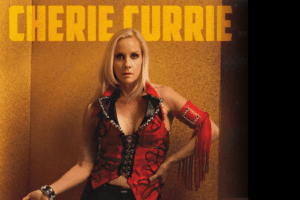 CHERIE CURRIE has an extraordinary life that reads like fiction. From a teenage rock star to becoming an accomplished Chainsaw Carving artist, Cherie has always taken the road less traveled.
CHERIE CURRIE has an extraordinary life that reads like fiction. From a teenage rock star to becoming an accomplished Chainsaw Carving artist, Cherie has always taken the road less traveled.
Cherie Currie was born and raised in the San Fernando Valley, where she spent her early teenage years living the Southern California lifestyle, with skateboarding and surfing being her pastimes of choice. Cherie would regularly sneak out to Paradise Cove to catch the waves on her eight-foot, blue, and yellow gunboard. Cherie describes her life at this time as “about as Ozzie & Harriet as it comes.” However, soon the idyllic existence ended with the demise of her parent’s marriage.
After the divorce, Cherie’s mother, a former Republic Studios contract actor, remarried and moved to Indonesia, taking Cherie’s younger brother Don with her. Cherie and her twin sister Marie moved in with their Aunt Evie, their Grandmother, Onie, and their father, Don.
Inspired by the music and image of David Bowie, Cherie found an escape and a raison d’être in rock & roll. The twins began frequenting the Sugar Shack, a club for teens in North Hollywood, which played all the hottest glam rock cuts coming out of the UK. It was there where she met producer and manager Kim Fowley and a young guitarist named Joan Jett, who also frequented the club. They were searching for a lead singer for the all-female rock band they were forming, which then consisted of Joan Jett on guitar and Sandy West on drums and was called The Runaways.
“Kim walked up to me and asked if I had heard of The Runaways, and I had,” she recalls. “Joan was there, and I was kind of star-struck, and Kim goes, ‘We really like your look.’”
Cherie was asked to learn a Suzi Quatro song for her audition, but when she arrived at the audition with “Fever,” a Peggy Lee original (which Quatro had covered), the band would not play the song. Unable to agree on a suitable alternate song, Joan and Kim wrote an impromptu audition piece, the chorus and title being a play on words referring to Cherie’s name and “cherry blonde bombshell” good looks. “Cherry Bomb” became one of The Runaways’ signature songs and still stands today as a universal anthem for teenage rebellion. For instance, “Cherry Bomb” was included in the 2014 blockbuster movie “Guardians of The Galaxy” and also on the accompanying multi-platinum-selling soundtrack album. The soundtrack album was nominated for a Grammy and was the #1 album on the Billboard Charts for two weeks. Cherie has received four certified platinum record awards for “Cherry Bomb” on the “Guardians of The Galaxy” soundtrack album.
Cherie was just 15 when she became The Runaways’ lead singer. “I was thrust into fronting a band. I’d never really sang; I’d never been on a stage with a live band,” says Cherie. “It was like being in the center of a hurricane; everything was moving so fast.” Within a month of Cherie joining The Runaways, the band secured a deal with Mercury Records. Two weeks later, they were in the studio recording their self-titled first album.
The Runaways faced opposition and criticism simply because they were unlike anything the world had seen before. They were a teenage all-girl band, which people hoped to dismiss; however, they delivered – technically and creatively – with maturity well beyond their years. With the triple threat of talent, self-assured sexuality, and style, The Runaways rocked as hard, if not harder, than the men in the male-dominated rock world. Their provocative image, which was augmented by the outrageous fishnets and corset Cherie wore for “Cherry Bomb,” would lay the groundwork for pop star fashion we still see today.
The release of their debut album in 1976 was followed by a national tour across America. During this time, the girls headlined bills over legendary bands such as Cheap Trick, Van Halen, Tom Petty, and The Ramones. By the time their sophomore album, Queens of Noise (1977), was released, The Runaways’ legend had gone international.
The band embarked on an international tour of Europe and then ultimately Japan, where Runaways mania had reached a fever pitch, as they were the fourth most popular international act there behind Led Zeppelin, ABBA, and Kiss.
Drained by their non-stop schedule, overworked, and underpaid, the already fractured and fragile group began to fall apart. A Live In Japan album was released as a coda to the tour. It was the last full-length release to feature the original Runaways lineup. Cherie left soon after the band’s return to the US.
Cherie soon followed up with the solo album Beauty’s Only Skin Deep in 1977, which was released internationally by Mercury. Having fulfilled her Mercury contract, she went on to record an album with her sister, Marie, on Capitol Records, entitled Messin’ With The Boys, in 1980.
During that same year, another of Cherie’s many talents took center stage. She was cast opposite Jodie Foster in Foxes, a coming-of-age movie set in the San Fernando Valley, where she played Annie, a teenage runaway, dabbling with substance abuse to cope with the scars inflicted by an abusive father.
Cherie got excellent notices for her acting in Foxes, which led to more roles in film (Wavelength with Robert Carradine, Parasite with Demi Moore, and Twilight Zone: The Movie with Dan Aykroyd) and TV (Murder She Wrote and Matlock).
Cherie recounted the story of her incredible ups and downs, dealing with success, as well as with her struggles with addiction, in her 1989 autobiography, Neon Angel: The Cherie Currie Story. Cherie was forced to leave much of the more salacious moments of her story out, as the book had been written specifically for the young adult market.


 CHERIE CURRIE
CHERIE CURRIE
